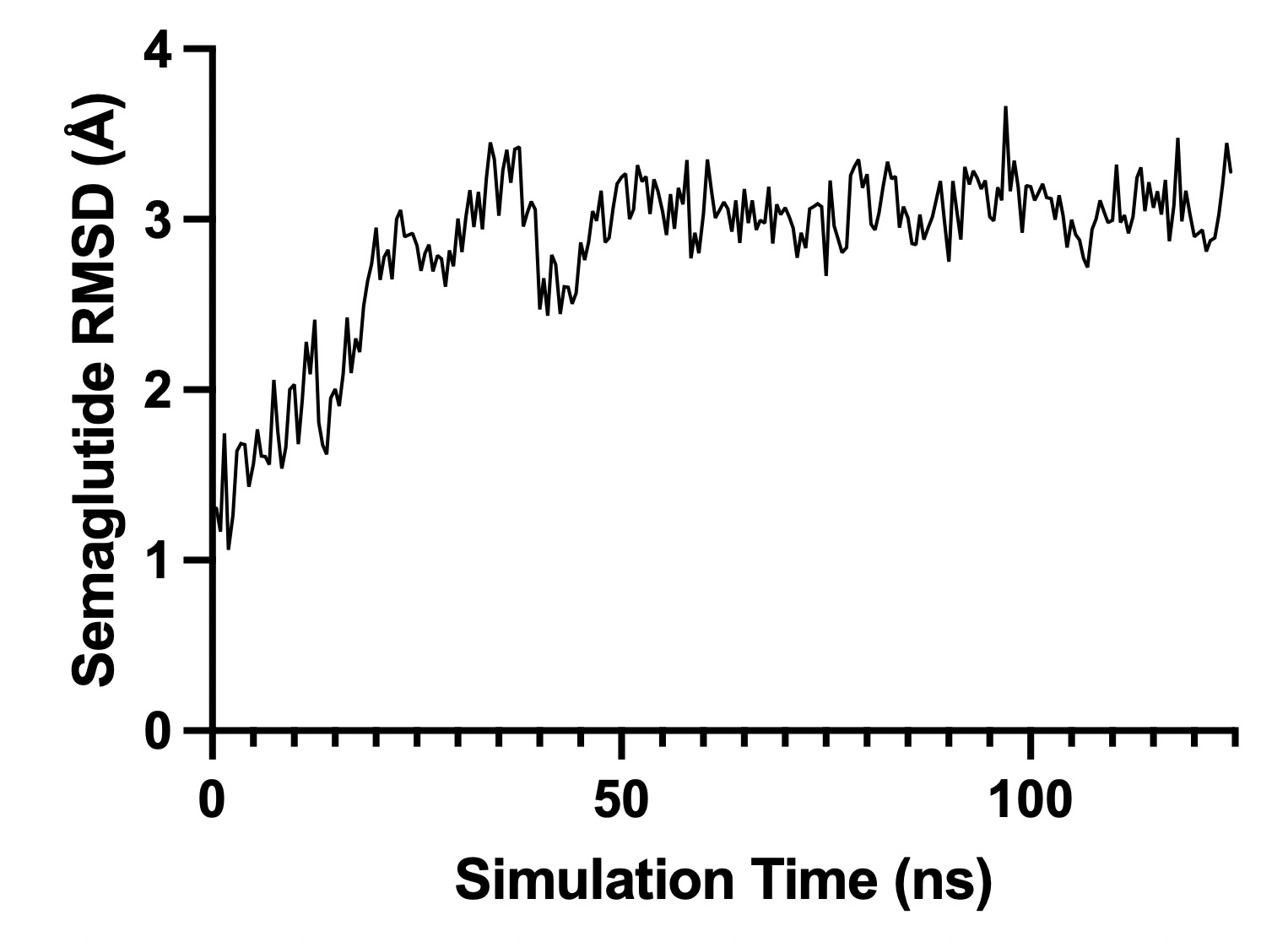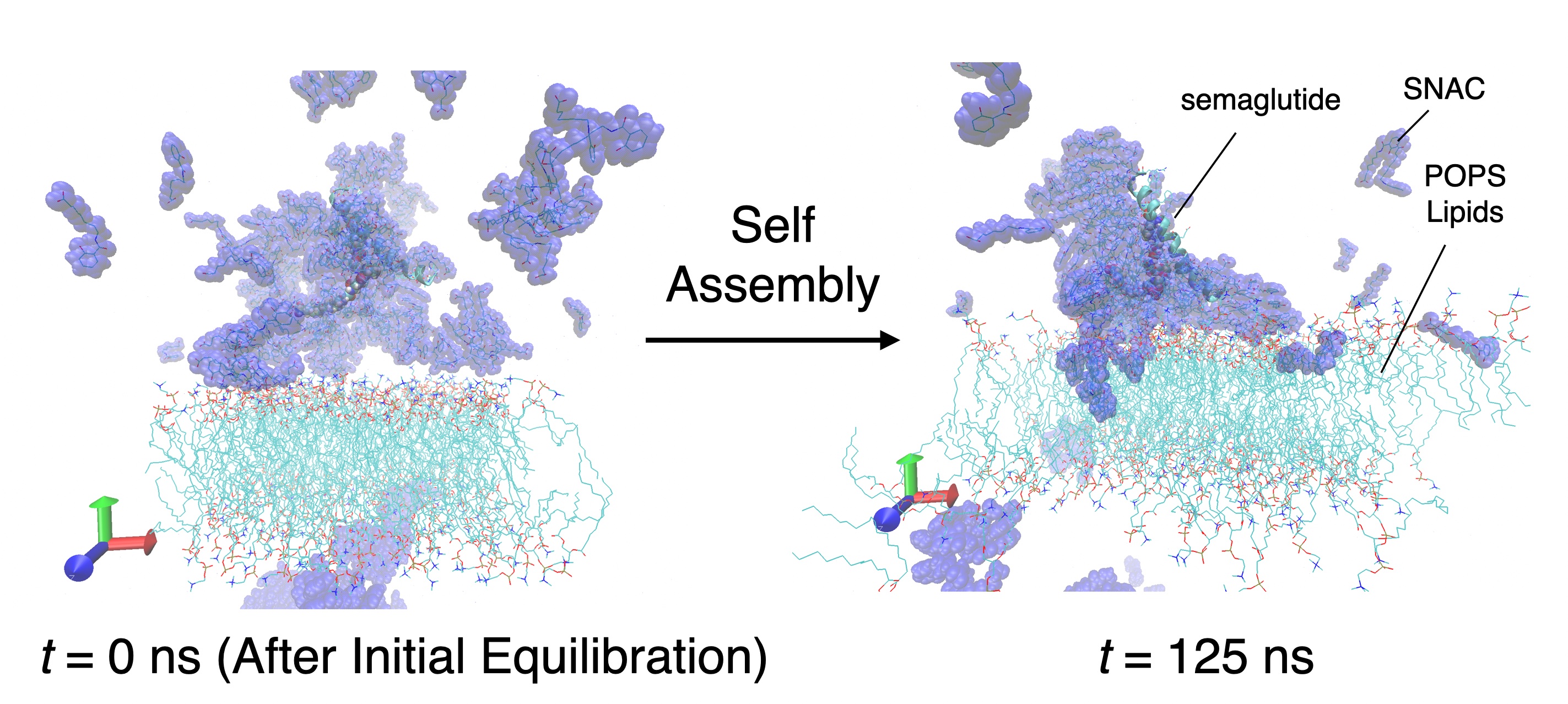Formulation and Delivery - Biomolecular
Category: Late Breaking Poster Abstract
(M0930-03-16) New Insight into the Oral Delivery Mechanism of Semaglutide Based on All-atom Molecular Dynamics Simulations
Monday, October 23, 2023
9:30 AM - 10:30 AM ET
- SS
Severin T. Schneebeli, Ph.D. (he/him/his)
Purdue University
West Lafayette, Indiana, United States - SS
Severin T. Schneebeli, Ph.D. (he/him/his)
Purdue University
West Lafayette, Indiana, United States - DN
Daijing Nie, M.D. (she/her/hers)
Purdue University
West Lafayette, Indiana, United States - KC
Kyle Colston, Ph.D. (he/him/his)
Purdue University
West Lafayette, Indiana, United States - JL
Jianing Li, Ph.D. (she/her/hers)
Purdue University
West Lafayette, Indiana, United States
Presenting Author(s)
Main Author(s)
Co-Author(s)
Purpose: The purpose of this study was to advance the fundamental knowledge of how permeation enhancers such as salcaprozate sodium (SNAC) enhance the oral uptake of peptide therapeutics. Even though permeation enhancers have been investigated since the 1960s and are now successfully used in the clinic, the detailed underlying mechanism of how specific permeation enhancers function with specific peptide drugs are not yet fully understood. In particular, it has been proposed that the permeation enhancer SNAC primarily enhances the absorption of semaglutide via a transcellular mechanism (for a recent review on the topic see reference 1) by increasing the fluidity of the membrane and/or forming a noncovalent complex with the semaglutide. However, these hypotheses are still under debate. Computational studies can help to further advance our understanding of these processes and (if coupled with the right experimental results in the future) might be able to ultimately confirm the underlying mechanisms underlying oral peptide absorption with transcellular permeation enhancers such as SNAC. Here, we now present new computational results, obtained by state-of-the-art all-atom molecular dynamics simulations, which clearly demonstrate that SNAC forms a non-covalent complex with semaglutide, which rapidly associates with the membrane.
Methods: The molecular dynamics simulations in the presence of the membrane model were carried out with the Amber 22 software package. The FF19SB force field was employed for the semaglutide, the GAFF force field for SNAC, and the LIPID14 force field for the lipid components. The water in the system was modeled with the TIP3P water model (which also contains appropriate parameters for the sodium and chloride ions in the system). Partial charges for the hydrophobic tail attached to LYS 26 of semaglutide as well as all the partial charges for SNAC were refined with the PyRed server tool, using electrostatic potential fitting in Gaussian 16 and appropriate charge constraints. The hydrophobic tail was split into four smaller fragments to obtain the partial charges. The setup of the membrane simulation system (with a POPC lipid bilayer system and appropriate periodic boundary conditions) was performed in Maestro. All charges were neutralized with sodium/chloride counter ions, and sodium chloride was added at a concentration of 0.15 M to more closely mimic physiological conditions. After assembly in Maestro, the system was minimized and then slowly heated to the production temperature of 310 K in the NVT ensemble. Finally, the system was equilibrated at 310 K in the NPT ensemble and production simulations were run at the same temperature for 125 ns. The simulations were wrapped and analyzed with the VMD software tool. The simulations used to investigate the flexibility of the hydrophobic tail of semaglutide were carried out with the Desmond software package for 500 ns and the OPLS4 force field implemented in the Schrodinger 2022 software package.
Results: Our results shown in Figures 1-3 show the detailed self-assembly pathway of semaglutide with the permeation enhancer SNAC in the presence of a lipid bilayer membrane containing POPC lipids. Key results from our all-atom molecular dymamics simulations include: While the hydrophobic tail of semaglutide is more flexible than the rest of the peptide drug -- it still has a preferred orientation with respect to the rest of the alpha-helical peptide. This finding is clearly shown in Figure 1, which shows different snapshots obtained during the MD trajectory of a free semaglutide in the presence of 200 SNAC molecules superimposed onto a representative structure of the semaglutide backbone. SNAC self-assembles with semaglutide rapidly (on the order of several nanoseconds) to form micelles with one face of the semaglutide (which includes the hydrophobic tail) attached to the SNAC micelles. In this process, the hydrophobic tail anchors the semaglutide in the SNAC micelle. Therefore, the SNAC seems to interact with the semaglutide in a somewhat ordered fashion, which might also be key for SNAC-enhanced transport of the semaglutide across the lipid bilayer membrane. The SNAC/semaglutide complex rapidly associates with the surface of the POPC lipid bilayer membrane. This process is primarily driven by the attractive electrostatic interactions between the positively charged phosphate head groups of the POPC lipids, and the negatively charged SNAC permeation enhancer (at pH > 5).
Conclusion: Our all-atom molecular dynamics simulation results show that semaglutide rapidly forms a somewhat ordered complex with excess SNAC in water. In the complex, the semaglutide binds to the surface of SNAC micelles, with the hydrophobic tail of the semaglutide engulfed in the SNAC micelle. This supramolecular complex (which is negatively charged due to the presence of the SNAC molecules) then rapidly associates with the positively charged phosphate head groups of the POPC lipids in our membrane model. Our results provide detailed structural evidence for complexation between the permeation enhancer SNAC and the therapeutic peptide semaglutide, advancing the fundamental understanding of how permeation enhancers might be able to transport therapeutic peptides across intestinal membranes.
References: 1. Pharmaceutics 2019, 11, 78; doi:10.3390/pharmaceutics11020078
Acknowledgements: This work was supported by the NIH (NIGMS grant R35-GM147579 awarded to S.T.S.)
 Figure 1. Conformational ensemble observed for the hydrophobic tail (shown in space-filling mode) of semaglutide during a 500 ns molecular dynamics trajectory of semaglutide in 0.15 M sodium chloride solution with 200 molecules of SNAC present. The structures of the hydrophobic tail are superimposed onto the averaged orientation of the semaglutide backbone (shown in cartoon mode). The hydrophobic tail resides mostly on one side of the semaglutide, which helps to anchor the semaglutide in a specific orientation at the surface of the micelles formed by the permeation enhancer SNAC.
Figure 1. Conformational ensemble observed for the hydrophobic tail (shown in space-filling mode) of semaglutide during a 500 ns molecular dynamics trajectory of semaglutide in 0.15 M sodium chloride solution with 200 molecules of SNAC present. The structures of the hydrophobic tail are superimposed onto the averaged orientation of the semaglutide backbone (shown in cartoon mode). The hydrophobic tail resides mostly on one side of the semaglutide, which helps to anchor the semaglutide in a specific orientation at the surface of the micelles formed by the permeation enhancer SNAC. Figure 2. Root mean square deviation (RMSD) from the starting structure of the production simulation with the semaglutide/SNAC/POPC-membrane system plotted over time. The plot clearly shows that the simulation is converged after about 50 ns.
Figure 2. Root mean square deviation (RMSD) from the starting structure of the production simulation with the semaglutide/SNAC/POPC-membrane system plotted over time. The plot clearly shows that the simulation is converged after about 50 ns. Figure 3. In-silico self-assembly of semaglutide with SNAC in the presence of a POPC lipid bilayer membrane. The initial snapshot for the 125 ns production simulation (run at 310 K in 0.15 M sodium chloride solution) as well as the final snapshot of the 125 ns production simulation are shown.
Figure 3. In-silico self-assembly of semaglutide with SNAC in the presence of a POPC lipid bilayer membrane. The initial snapshot for the 125 ns production simulation (run at 310 K in 0.15 M sodium chloride solution) as well as the final snapshot of the 125 ns production simulation are shown.